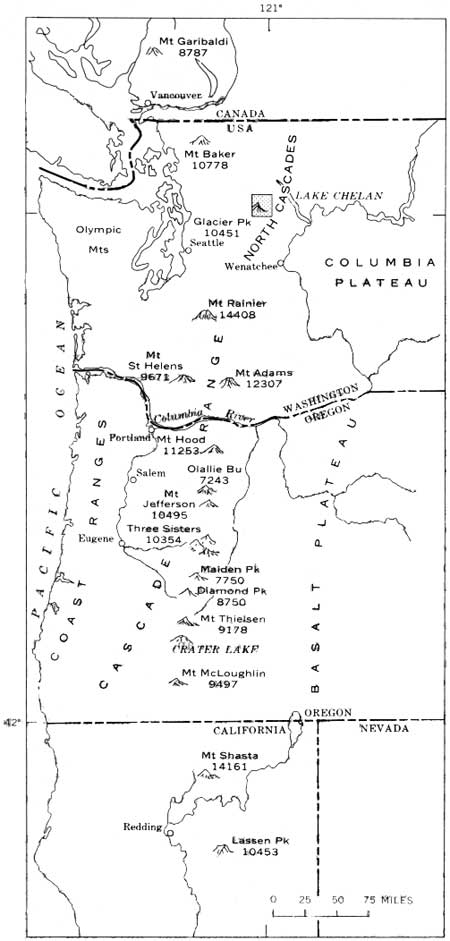
|
Geological Survey Professional Paper 604
On Batholiths and Volcanoes—Intrusion and Eruption of Late Cenozoic Magmas in the Glacier Peak Area, North Cascades, Washington |
INTRODUCTION
PROBLEM
In early Miocene time, the Cloudy Pass batholith intruded the metamorphic rocks of the North Cascades between Glacier Peak and Lake Chelan. Intrusive breccias and hypabyssal phases suggest that the magma came close to the surface and probably erupted. After the cooling of at least the upper part of the pluton, it was exposed by erosion and volcanic and volcaniclastic rocks were deposited on or near it. In Pleistocene time, a dacitic volcano, Glacier Peak (fig. 1), began to form; its last eruption was about 12,000 years ago. During this last phase of activity of the volcano, basaltic cinder cones grew nearby.

|
| FIGURE 1.—Quaternary volcanoes of the Cascade Range and area of figure 2. Adapted from Williams (1944, fig. 1) (click on image for an enlargement in a new window) |
We earlier suggested (in Hopson and others, 1966) that the proximity of the batholith to most of the volcanic rocks and their chemical similarity indicate a genetic relationship. Batholithic magmas which erupted are no strangers to the Cascades of Washington. Fuller (1925) described the explosive deroofing of the Snoqualmie batholith to form flows and volcaniclastic rocks of late Miocene and early Pliocene age. Details of the eruptive history of the Miocene Tatoosh pluton in the Mount Rainier area were aptly given by Fiske, Hopson, and Waters (1963, p. 52-63), who postulates a possible genetic tie between the batholith and the volcano of Mount Rainier (p. 91). Cater (1960; 1969) described a link between the Cloudy Pass batholith and volcanism in the Holden quadrangle. This paper describes the batholith and the volcanic rocks that occur in the adjoining Glacier Peak quadrangle and examines the evidence for kinship of these rocks. The volcanic rocks of the early episode of volcanism on Gamma Ridge may well be derived from the batholith. Such an origin for the later lavas of Glacier Peak is unlikely, although there may well be a genetic relationship in ultimate source or process.
ACKNOWLEDGMENTS
We owe much to fellow students of North Cascade geology for both fundamental work and valuable discussion, in particular to Fred Cater, Cliff Hopson, Art Ford, Bob Grant, and Ray Wilcox. Others who have given pertinent advice and opinions are Paul Bateman, Dave Hopkins, Jack Lockwood, George Walker, Don Swanson, Don Tatlock and Ron Kistler. We especially thank Art Ford, who loaned us his specimens of Glacier Peak lavas, and George Tilton, who furnished unpublished data on lead isotopes.
| <<< Previous | <<< Contents >>> | Next >>> |
/pp/604/intro.htm
Last Updated: 28-Mar-2006